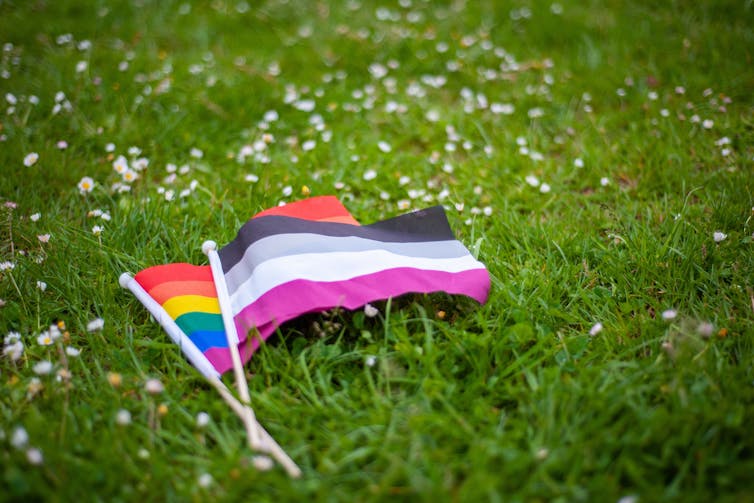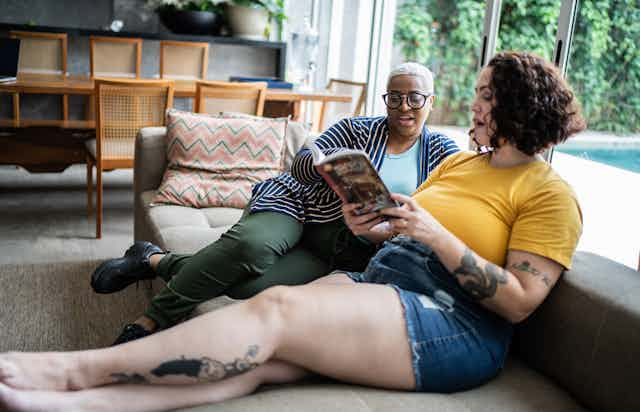In recent years, we’ve seen a burgeoning social movement for the acceptance of asexuality. We’ve also seen more asexual characters popping up in shows such as Heartstopper and Sex Education.
Despite this, asexuality remains widely misunderstood. So what does it mean?
Asexuality refers to low or no sexual attraction. However, this does not mean all people who identify as asexual, or the shorthand “ace”, never experience sexual attraction or never have sex.
People who identify as asexual may feel intense romantic attraction to someone, but not sexual attraction. Others may find sex pleasurable but rarely feel attracted to another person.
Read more: How asexuals navigate romantic relationships
There are also variations of asexual identity that fit broadly within the ace umbrella. People who identify as demisexual, for example, experience sexual attraction only to people with whom they have a strong emotional bond.
Across the spectrum of ace identities, many people have romantic or sexual relationships. For others, sex is not part of their lives.
Asexual identity also cuts across other sexual or gender identities. Some asexual people identify as queer, transgender or gender diverse.
How many people identify as asexual?
Asexuality, as a sexual identity or orientation, has only recently been included in large-scale surveys. So data is limited.
Analysis of data from a 2004 British population-based survery found 1% of respondents indicated, “I have never felt sexually attracted to anyone at all”. This measure, however, may not be accurate given many asexual people wouldn’t agree they have “never” felt sexual attraction.
In 2019, a large Australian survey of the lesbian, gay, bisexual, transgender, queer, intersex and asexual (LGBTQIA+) communities, showed 3.2% of the sample identified as asexual.
The Asexual Visibility and Education Network, an international online network, has more than 120,000 members.
When did asexuality become a social movement?
Asexuality has always been part of human sexual diversity. However, the movement to establish asexuality as a sexual identity, and build a community around this, has its roots in the early 2000s.
The rise of internet technologies created a platform for asexual people to connect and organise, following a similar path to lesbian, gay, bisexual and transgender rights activists.

Asexuality, as an identity, sits alongside heterosexuality, homosexuality or bisexuality as a description of self that is determined by the shape of one’s desire.
However, the significance of defining asexuality as an “identity” is often misunderstood or critiqued on the basis that many people experience low or no sex drive at some points in their life.
What’s the difference between sexual identity and sex drive?
In his work on the history of sexuality, sociologist Jeffrey Weeks points to the psychoanalytic interrogation of men attracted to men as a milestone in the contemporary Western understanding of sexuality. It was at this point, in the late 1800s, that “homosexuality” came to be seen as core to an individual’s psyche.
Before this, homosexual sex was often considered sinful or degenerate, but sex was seen as just a behaviour not an identity – something a person does, not who they “are”. There was no category of “the homosexual” and heterosexuality was only determined in response to this categorisation of sexuality.
This history means that, today, sexual identity is considered an important part of what defines us as a person. For lesbian, gay or bisexual people, “coming out” is about building a sense of self and belonging in the face of institutional and cultural opposition to homosexuality.
Read more: Friday essay: hidden in plain sight — Australian queer men and women before gay liberation
Asexuality has not been subject to legal or moral sanction in the ways that homosexuality has. However, many asexual people similarly do not conform to conventional expectations regarding sex, relationships and marriage. Families and communities often don’t accept or understand asexuality.
Sexual relationships are central to the expectations we place on ourselves and others for a “good” life. Sex and desire (or desirability), not to mention marriage and childbearing, are highly valued. People who are asexual, or who do not desire sex, are often given the message that they are “broken” or inadequate.

This can be reinforced through medical or psychological definitions of low sex drive as a problem that should be fixed. Hypo-active sexual desire disorder is a category within the Diagnostic and Statistical Manual of Mental Disorders, the handbook mental health professionals use to diagnose mental disorders.
While diagnostic categories are important to support people who experience distress due to low sex drive, they can also mean asexuality is viewed in pathological terms.
Building awareness of asexuality as a legitimate sexual identity is about resisting the view that asexuality is a deficit.
By challenging us to rethink everyday assumptions about human sexual experience, the asexuality movement is far from anti-sex. Rather, affirming and celebrating the legitimacy of asexual identity is very much a sex-positive stance – one that asks us to expand our appreciation of sexual diversity.
Read more: What asexuality can teach us about sexual relationships and boundaries

